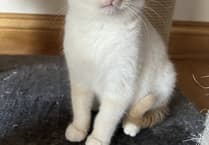The common lizard is the UK’s most widespread reptile, but its numbers are declining; and it’s the only land-based reptile native to the Isle of Man (although there are many myths about the presence of snakes).
Lizards can be found in a variety of habitats from woodland to moorland, and you are most likely to see one between March and October – basking on a rock or wooden post, soaking up the sun.
The lizards are in the middle of their mating season now (April/May) and their young will arrive in July, with the number varying from three to eleven.
The common lizard is unusual among reptiles because it incubates its eggs inside its body, rather than laying them, and gives birth to live young.
The lizard feeds on small invertebrates such as flies, spiders and even snails, and it hunts by day using sight and scent.
In turn they are a food source for many birds of prey. If a lizard feels threatened by a predator, it can detach its still-moving tail in order to distract the attacker and escape – leaving the decoy behind.
The loss of the tail leaves a scar but the tail can regrow, usually as a shortened version of the original.
A reptile’s skin doesn’t grow and so they have to shed a layer of it, known as sloughing or molting, allowing a new, larger layer to come through.
This process also enables the lizard to get rid of any parasites it may have picked up.
If you are lucky enough to spot one you’ll see a creature about 10 to 15cm in length, with a tail that makes up over half its length, and a small, pointed head.
It is usually brown in colour with a pattern of stripes or spots down its back and sides.
Males have bright yellow or orange speckled bellies, and females have paler and plainer ones, and they can expect to live for up to seven years.
They are protected by the Wildlife Act 1990 (and the revised order in 2004) and they cannot be captured or removed except under license.
The places where they choose to shelter are also protected and they cannot be deliberately damaged, destroyed or obstructed.
It is also an offence to sell, trade, injure or kill the common lizard.
These amazing little creatures need sunshine to heat up their bodies in order to remain active, and so they hibernate between October and March underneath rocks and fallen logs, usually within a small group of other lizards.
A good tip for lizard spotting is to walk slowly along a path, scanning either side for possible basking sites.
The rustling movement of a lizard darting for cover is often the first sign you’ll get of their presence, but it’s worth waiting quietly when this happens because lizards tend to stick to the same sunbathing spots and will return to them.
If you do see a common lizard then please let Manx Wildlife Trust know (email: [email protected]), ideally with a grid reference and a photograph, so that they can map the distribution of lizards around the island and try to measure their population.
As regards reptiles as pets, we think there’s a declining trend in the private ownership of bearded dragons, geckos, snakes, etc because we have less of them coming to us for re-homing than we did several years ago.
They need specialist husbandry and need heated vivariums to live in, and they have very specific dietary requirements – usually involving live insects; and they are not children’s pets.




